Union Pacific Bundle
How Does Union Pacific Power the American Economy?
Union Pacific, a leading Union Pacific SWOT Analysis, isn't just a railroad company; it's a vital artery of the U.S. economy. Its impressive Q1 2024 operating ratio of 60.7% and earnings per share of $2.69 highlight its financial prowess and operational efficiency. This freight transportation giant's expansive rail network plays a crucial role in the movement of goods across the nation.
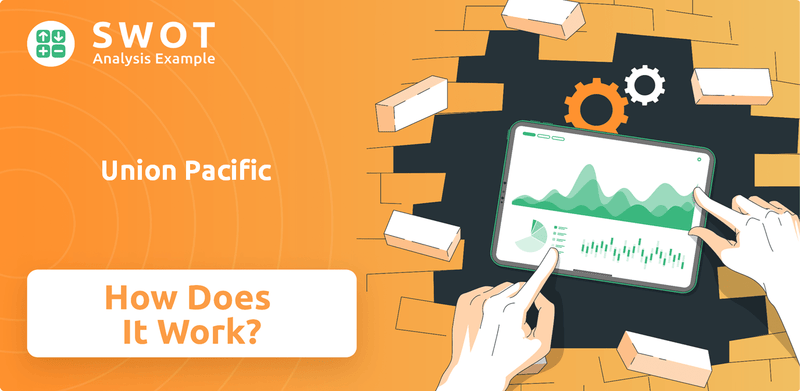
Understanding Union Pacific operations is key for investors, customers, and anyone tracking economic trends. Its vast network, spanning 23 states, is integral to the supply chain, impacting consumer prices and manufacturing. The company's commitment to innovation and sustainability, such as its battery-electric locomotives, positions it for continued success in a dynamic market. This analysis will explore how Union Pacific, a major player in the rail industry, navigates challenges and capitalizes on opportunities.
What Are the Key Operations Driving Union Pacific’s Success?
The core operations of Union Pacific (UP) revolve around providing essential freight transportation services. The company's primary value proposition lies in its ability to efficiently and reliably transport a wide array of goods across its extensive rail network. This network serves as a critical artery for the U.S. economy, connecting businesses and markets across the western two-thirds of the country.
UP Railroad's core offerings encompass the movement of diverse commodities. These include agricultural products, automotive parts, chemicals, coal, industrial goods, and intermodal containers carrying consumer goods. The company focuses on providing cost-effective and environmentally friendly transportation solutions, especially for bulk commodities and long-haul movements, differentiating it from other modes of transport.
The operational processes are complex and highly integrated. This includes meticulous route planning, advanced signaling systems, and extensive maintenance programs. UP leverages sophisticated technology, including its precision scheduled railroading (PSR) operating model, to enhance efficiency, reduce transit times, and improve asset utilization. Its vast distribution networks connect major ports, production hubs, and consumption centers.
UP transports a wide variety of goods, including agricultural products, automotive parts, chemicals, and intermodal containers. These services are crucial for various industries and contribute significantly to the U.S. economy. UP's extensive rail network ensures the efficient movement of these goods across the country.
The company utilizes advanced technologies and operational models like PSR to enhance efficiency. This includes route optimization, advanced signaling, and comprehensive maintenance programs. These efforts lead to reduced transit times and improved asset utilization, ensuring reliable service.
UP collaborates with other railroads and drayage companies to optimize its supply chain. These partnerships facilitate interline traffic and first/last-mile delivery, improving the overall efficiency of its freight transportation services. This collaborative approach enhances its service offerings.
UP offers cost-effective and environmentally friendly transportation solutions, especially for bulk commodities and long-haul movements. This differentiates it from other modes of transport. The company's focus on efficiency and reliability translates into reduced shipping costs and improved supply chain predictability for its customers.
UP's operations are effective due to its massive scale, geographic reach, and continuous investment in technology. This translates into customer benefits such as reduced shipping costs and improved supply chain predictability. UP's focus on efficiency and reliability solidifies its market differentiation.
- Extensive Network: Connecting major ports, production hubs, and consumption centers.
- Technological Advancement: Utilizing PSR and other technologies to enhance efficiency.
- Cost-Effective Solutions: Offering competitive rates for bulk commodities and long-haul movements.
- Environmental Benefits: Providing a more sustainable transportation option compared to other modes.
Union Pacific SWOT Analysis
- Complete SWOT Breakdown
- Fully Customizable
- Editable in Excel & Word
- Professional Formatting
- Investor-Ready Format
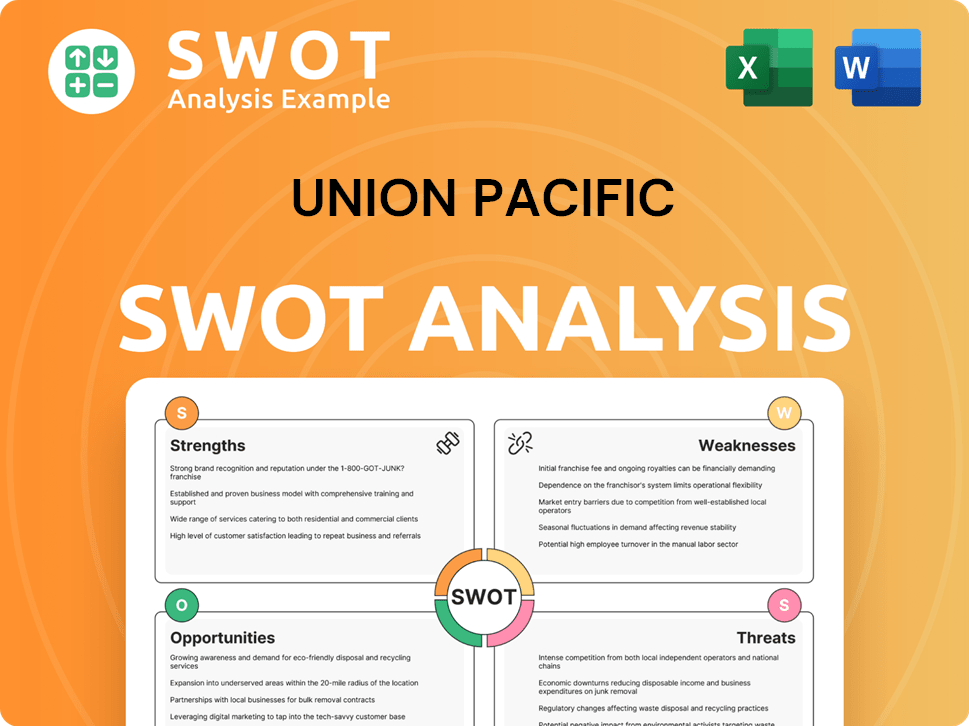
How Does Union Pacific Make Money?
The primary revenue streams for the railroad company, Union Pacific, are generated through its freight transportation services. These services are categorized by the types of commodities transported, reflecting the diverse range of goods essential to the economy. In 2023, the company reported operating revenues of $24.1 billion, and in the first quarter of 2024, operating revenues were $6.0 billion, demonstrating its significant financial scale.
Union Pacific's monetization strategies center on the volume and distance of goods hauled, with pricing influenced by factors like commodity type, service levels, and market demand. The company continually refines its operations to enhance efficiency and meet evolving market needs. A deeper understanding of Brief History of Union Pacific can provide additional context.
The company's revenue is diversified across several key segments, each contributing to its overall financial performance. These segments reflect the breadth of Union Pacific's operations and its role in supporting various sectors of the economy.
The main revenue streams include transportation of agricultural products, automotive goods, chemicals, coal, industrial products, and intermodal freight. Each segment contributes differently to the overall revenue, reflecting market dynamics and economic trends. The company's ability to adapt to these shifts is crucial for its continued success.
- Agricultural Products: Transportation of grains, fertilizers, and food products.
- Automotive: Shipping finished vehicles and parts.
- Chemicals: Movement of plastics, industrial chemicals, and petroleum products.
- Coal: Transporting coal for power plants and export.
- Industrial Products: Hauling construction materials, metals, and manufactured goods.
- Intermodal: Transporting containers between different modes of transport, a growing area.
Union Pacific PESTLE Analysis
- Covers All 6 PESTLE Categories
- No Research Needed – Save Hours of Work
- Built by Experts, Trusted by Consultants
- Instant Download, Ready to Use
- 100% Editable, Fully Customizable
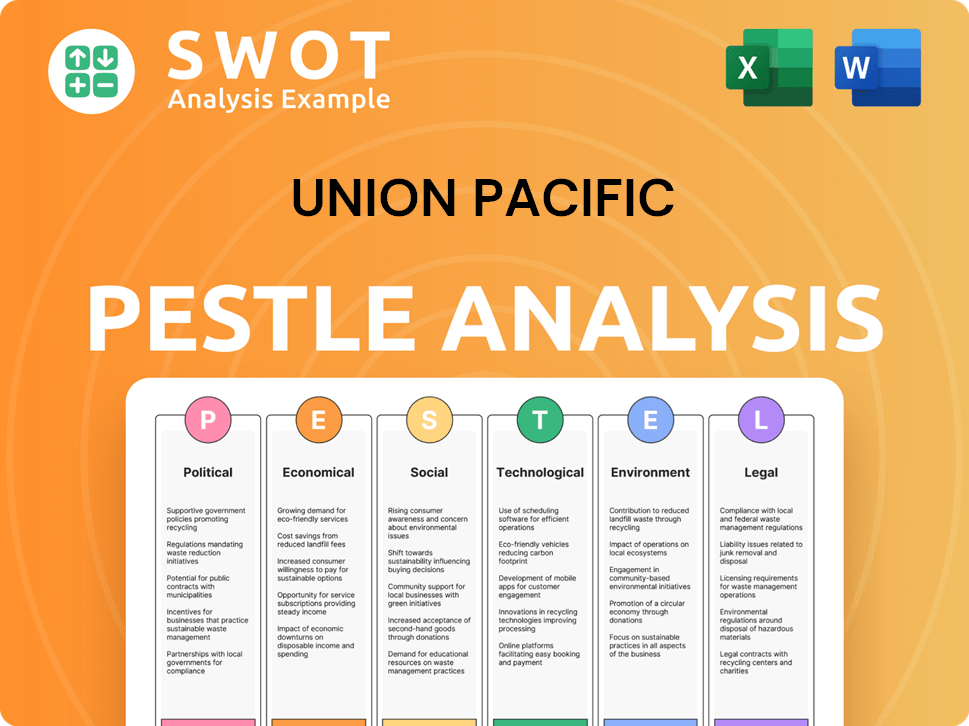
Which Strategic Decisions Have Shaped Union Pacific’s Business Model?
The history of Union Pacific (UP Railroad) is marked by significant milestones and strategic shifts that have shaped its operational and financial performance. A key strategic move in recent years has been the implementation of Precision Scheduled Railroading (PSR). This model aims to enhance efficiency, reduce costs, and improve service reliability by optimizing asset utilization and streamlining operations.
Operational challenges have included supply chain disruptions, such as those during the COVID-19 pandemic, which led to congestion and service inconsistencies. The company responded by focusing on crew availability, network fluidity, and customer communication. Regulatory hurdles also continuously influence operations, prompting investments in cleaner technologies and safety protocols.
Union Pacific's competitive advantages are multifaceted, including its immense brand strength and technology leadership. The economies of scale derived from operating the largest rail network in North America provide significant cost efficiencies. The company continues to adapt to new trends by investing in digital transformation and focusing on sustainability initiatives.
Union Pacific's history spans over 160 years, marked by mergers, acquisitions, and expansions. Key milestones include the completion of the first transcontinental railroad. The company has consistently adapted to technological advancements and market changes to maintain its position in the freight transportation industry.
The implementation of Precision Scheduled Railroading (PSR) is a pivotal strategic move. This operational model aims to improve efficiency, reduce costs, and enhance service reliability. Investments in technology, such as advanced rail operations management systems, are also key strategic initiatives.
Union Pacific's competitive edge stems from its extensive rail network and brand recognition. The company benefits from economies of scale, technology leadership, and a focus on customer service. Its ability to connect diverse markets and provide seamless transportation solutions is also a key advantage.
Operational challenges include supply chain disruptions and regulatory hurdles. The company addresses these challenges by focusing on crew availability, network fluidity, and customer communication. Investments in cleaner technologies and safety protocols are also crucial.
In Q1 2024, Union Pacific reported continued progress with PSR, contributing to its improved operating ratio. The company is investing in battery-electric locomotives, deploying 20 units by late 2024, demonstrating a commitment to reducing emissions. For more insights, consider reading about the Marketing Strategy of Union Pacific.
- Union Pacific's revenue in 2023 was approximately $24.1 billion.
- The company's operating ratio improved, reflecting efficiency gains from PSR.
- Capital expenditures are directed towards maintaining and upgrading infrastructure.
- Sustainability initiatives include reducing carbon emissions and promoting environmental responsibility.
Union Pacific Business Model Canvas
- Complete 9-Block Business Model Canvas
- Effortlessly Communicate Your Business Strategy
- Investor-Ready BMC Format
- 100% Editable and Customizable
- Clear and Structured Layout
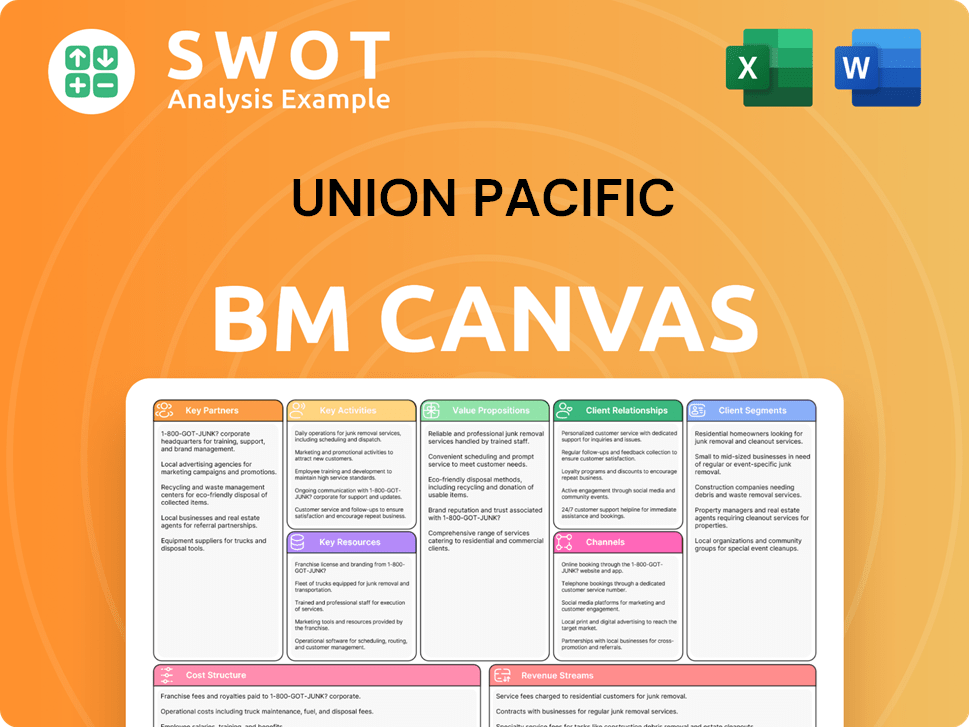
How Is Union Pacific Positioning Itself for Continued Success?
The [Company Name] holds a strong position in the North American freight rail industry, especially in the western United States. As one of the two major Class I railroads operating in that region, its extensive rail network connects key ports, production centers, and consumption hubs across 23 states, giving it a significant competitive edge. This position is reinforced by high barriers to entry and the essential nature of its services to many businesses' supply chains.
Despite its strong market position, [Company Name] faces risks from regulatory changes, emerging competitors, and technological disruptions. Economic downturns and shifts in consumer preferences also pose challenges. The company actively works to mitigate these risks through strategic initiatives, including investments in technology and infrastructure, to maintain its critical role in the national supply chain. A deeper dive into Growth Strategy of Union Pacific can provide more insight.
The [Company Name] is a leading railroad company in the western United States. It competes primarily with BNSF Railway, controlling a significant portion of the freight transportation market. The company's vast rail network connects major economic centers.
Key risks include regulatory changes, competition from other modes of transport, and economic cycles. Technological advancements, such as autonomous trucking, also pose potential challenges. Changes in demand for commodities, like coal, impact revenue streams.
The future involves leveraging its established network and operational expertise. It aims to capitalize on economic growth and adapt to evolving market demands. Strategic initiatives include investments in technology and infrastructure.
In 2024, [Company Name] reported revenues of approximately $24.1 billion. The company's operating ratio, a key efficiency metric, was around 60.9% in 2024, reflecting its operational performance. Capital expenditures for 2024 were approximately $3.9 billion, demonstrating ongoing investment in infrastructure and technology.
- Revenue: Approximately $24.1 billion (2024).
- Operating Ratio: Approximately 60.9% (2024).
- Capital Expenditures: Approximately $3.9 billion (2024).
- Focus on Precision Scheduled Railroading (PSR) to improve efficiency.
Union Pacific Porter's Five Forces Analysis
- Covers All 5 Competitive Forces in Detail
- Structured for Consultants, Students, and Founders
- 100% Editable in Microsoft Word & Excel
- Instant Digital Download – Use Immediately
- Compatible with Mac & PC – Fully Unlocked
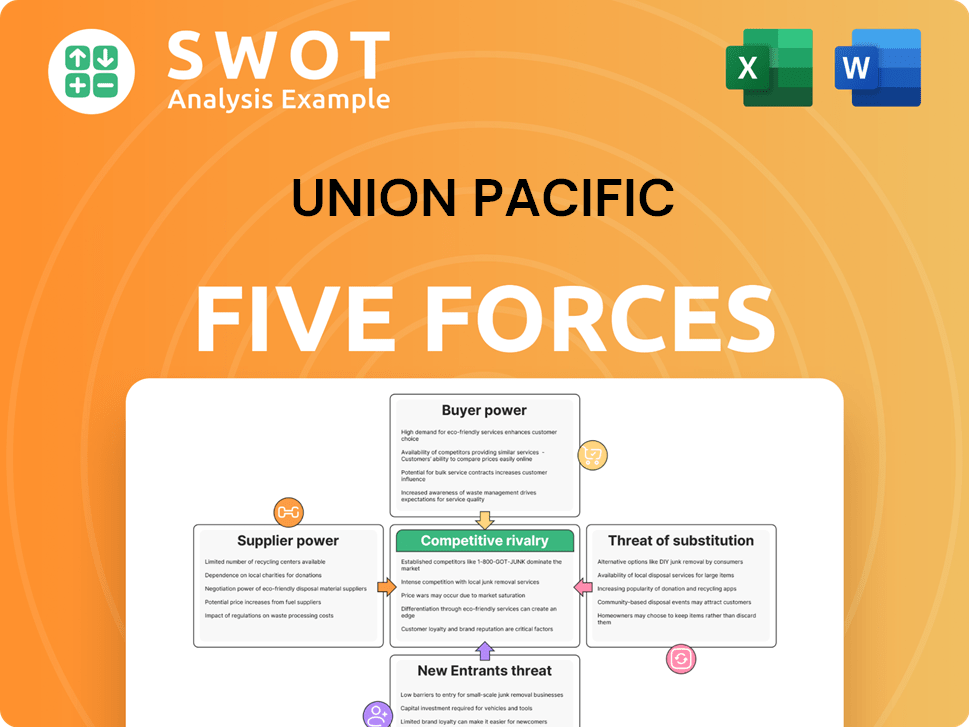
Related Blogs
- What are Mission Vision & Core Values of Union Pacific Company?
- What is Competitive Landscape of Union Pacific Company?
- What is Growth Strategy and Future Prospects of Union Pacific Company?
- What is Sales and Marketing Strategy of Union Pacific Company?
- What is Brief History of Union Pacific Company?
- Who Owns Union Pacific Company?
- What is Customer Demographics and Target Market of Union Pacific Company?
Disclaimer
All information, articles, and product details provided on this website are for general informational and educational purposes only. We do not claim any ownership over, nor do we intend to infringe upon, any trademarks, copyrights, logos, brand names, or other intellectual property mentioned or depicted on this site. Such intellectual property remains the property of its respective owners, and any references here are made solely for identification or informational purposes, without implying any affiliation, endorsement, or partnership.
We make no representations or warranties, express or implied, regarding the accuracy, completeness, or suitability of any content or products presented. Nothing on this website should be construed as legal, tax, investment, financial, medical, or other professional advice. In addition, no part of this site—including articles or product references—constitutes a solicitation, recommendation, endorsement, advertisement, or offer to buy or sell any securities, franchises, or other financial instruments, particularly in jurisdictions where such activity would be unlawful.
All content is of a general nature and may not address the specific circumstances of any individual or entity. It is not a substitute for professional advice or services. Any actions you take based on the information provided here are strictly at your own risk. You accept full responsibility for any decisions or outcomes arising from your use of this website and agree to release us from any liability in connection with your use of, or reliance upon, the content or products found herein.